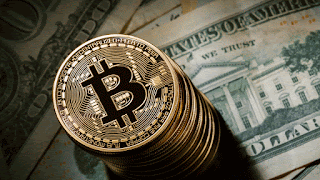Cryptocurrency: Is Bitcoin the new gold?
The price of Bitcoin is going up every day, every hour, every moment!
So is it fair to call Bitcoin the new gold? Financial experts have for long dismissed the notion that Bitcoins(or decentralized Cryptocurrencies) are the future. But as of December 2017, Bitcoin is trading at an all time high of $11,000 and has surged more than 10x this year alone. It might be fair to state that price at which it is trading is fairly high and we might see a correction in the near future. Or even a crash!
But the one thing everyone can count on is- Bitcoin is here to stay. Cryptocurrencies are the future and it marks the beginning of the end of centralized financial institutions. While some people like the Oracle of Omaha have likened the Bitcoin bubble to the dot-com bubble, it does not discount the fact that Cryptocurrencies are here to stay. So before you start investing in Bitcoins, it might be better to have an understanding of the underlying structure.
What is Cryptocurrency?
Wikipedia describes cryptocurrency (or crypto
currency) as a digital asset designed to work as a medium of
exchange using cryptography(the practice and study of techniques or secure
communication in the presence of third
parties called adversaries) to secure the transactions, to control the
creation of additional units, and to verify the transfer of assets.
Cryptocurrencies are classified as
a subset of digital currencies and
are also classified as a subset of alternative
currencies(altcoins) and virtual currencies.
The first decentralized
cryptocurrency Bitcoin was created in 2009. A cryptocurrency use
decentralized control as opposed to centralized banking systems.
The underlying technical system
upon which decentralized cryptocurrencies are based was created by the group or
individual known as Satoshi Nakamoto(Satoshi
Nakamoto is the name used by the unknown person or people who
designed bitcoin). Other promising cryptocurrencies include Ethereum, Litecoin, Ripple, Dash, Iota, Monero and Zcash.
The golden boy: Bitcoin
Bitcoin is a cryptocurrency and a worldwide payment
system created in 2009. There is no doubt that Bitcoin is the start of the show leading the digital currency revolution. Even though the prices are sky high and is touted to touch $40,000 in the near future, Bitcoin does not have a central repository. The
peer-to-peer transactions take place directly, without an intermediary through
the use of cryptography. The transactions are verified by network nodes and
recorded in a public distributed ledger called a blockchain.
The philosophy of bitcoin is that it's a limited digital asset. There's only 21 million bitcoin. The smallest amount you can get is not one bitcoin, you can get fractions of bitcoin. But if you own 1 bitcoin or 0.1 bitcoin you'll forever have that percentage of the world's supply. Until now only about 16 million Bitcoins have been mined and the rest will be mined in the coming years. The supply is limited and the demand is high, hence the sky-high prices.
Blockchain: A
blockchain is a continuously growing list of records, called blocks, which are
linked and secured using cryptography. The
first blockchain was conceptualised in 2008 by Satoshi Nakamoto and
implemented in 2009 as a core component of bitcoin where it serves as the public ledger for all transactions. Blockchain is a type of distributed ledger for
maintaining a permanent and tamper-proof record of transaction data. A
blockchain functions as a decentralized database that is
managed by computers belonging to a peer-to-peer (P2P) network. Each of the
computers in the distributed network maintains a copy of the ledger to prevent
a single point of failure (SPOF) and all copies are updated and validated
simultaneously. This means that every personal computer in the blockchain records every transaction. The invention of the blockchain for bitcoin thus made it the first digital currency to solve the double spending problem without the need of a trusted authority or central server. The bitcoin design has been the inspiration for other applications.
A "Trade-A" executed by one user is recorded as a "Trade-A" in the blockchain and hence only one user get the rights to a particular transaction.
How blockchain works?
A blockchain ledger consists of two types of
records: individual transactions and blocks. The first block consists of a header and
data that pertains to transactions taking place within a set time period. The
block’s time stamp is used to help create an alphanumeric string called a hash.
After the first block has been created, each
subsequent block in the ledger uses the previous block’s hash to calculate its
own hash. Before a new block can be added to the chain, its authenticity must
be verified by a computational process called validation or consensus. At this
point of the blockchain process, a majority of nodes in the network must agree
the new block’s hash has been calculated correctly. Consensus ensures that all
copies of the distributed ledger share the same state.
Once a block has been added, it can be referenced
in subsequent blocks, but it cannot be changed. If someone attempts to swap out
a block, the hashes for previous and subsequent blocks will also change and
disrupt the ledger’s shared state. When consensus is no longer possible, other
computers in the network are aware that a problem has occurred and no new
blocks will be added to the chain until the problem is solved. Typically, the
block causing the error will be discarded and the consensus process will be
repeated.
What is Bitcoin mining?
Bitcoin mining is analogous to gold mining. Mining involves solving computational problems using high performance processors. As the number of blocks increase, the complexity of the problems also increase. Every time a "miner" mints a Bitcoin , it is added to the blockchain.
The resources used for mining are the CPU or processor, and the electricity.
Mining is a distributed consensus system that is used to confirm waiting transactions by including them in the block chain. It enforces a chronological order in the block chain, protects the neutrality of the network, and allows different computers to agree on the state of the system. To be confirmed, transactions must be packed in a block that fits very strict cryptographic rules that will be verified by the network. These rules prevent previous blocks from being modified because doing so would invalidate all following blocks. Mining also creates the equivalent of a competitive lottery that prevents any individual from easily adding new blocks consecutively in the block chain. This way, no individuals can control what is included in the block chain or replace parts of the block chain to roll back their own spends.
Basics for a new user
As a new user, one can transact using Bitcoins without understanding the technicalities involved in cryptography and blockchains. Once you signup on a Bitcoin wallet, it creates your Bitcoin address required to buy Bitcoins. This Bitcoin address is used in the transaction of Bitcoins used for buying or selling. Bitcoin wallets keep a secret piece of data called a private key or seed, which is used to sign transactions, providing a mathematical proof that they have come from the owner of the wallet. The signature also prevents the transaction from being altered by anybody once it has been issued. All transactions are broadcast between users and usually begin to be confirmed by the network in the following 10 minutes, through a process called mining.
Conclusion
In the coming years, there is no doubt that Bitcoin along with the other digital currencies will replace at least a major part of the traditional currencies that we use in our day-to-day lives. Since they are an international currency, you can use them in any country without having to convert between currencies. This can result in a saving billions of dollars in transaction fee every year. This also means that the traditional banking system is going to be disrupted. The recent comments by the JP Morgan chief can be seen as a resistance to the threat the digital currencies pose to the banking system. In addition to this, the Blockchain is really secure and fast. All of these will definitely help Bitcoin get more users, and if everyone uses Bitcoin it could replace official currencies. Sure, it has some disadvantages, but some of those are because Bitcoin is a new thing, so as time goes on they will be less of a problem.
So, is Bitcoin the new gold?
It is up to the users to decide.
Email- praveencherianjacob@gmail.com
Mobile: +919744108819
P.S: Excerpts taken from sources listed below
Source of images, if any: Google
Sources: http://searchcio.techtarget.com/definition/blockchain
https://bitcoin.org/en/how-it-works
https://bitcoin.org/bitcoin.pdf
https://yourstory.com/2017/11/cryptocurrencies-types/



Comments
Post a Comment